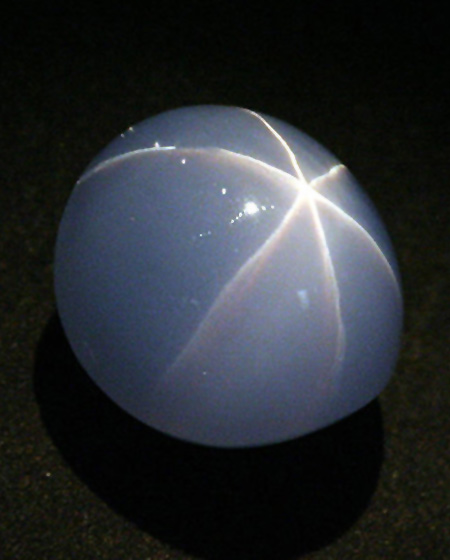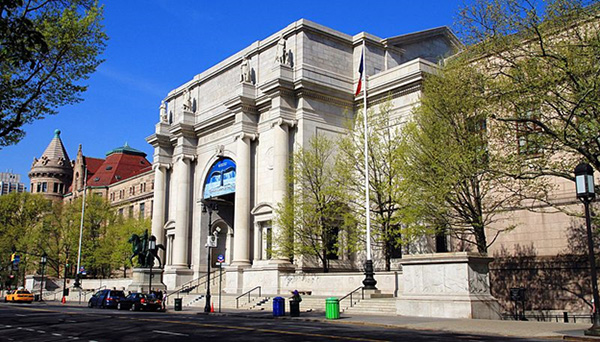
In October 1964, three young thieves cased the American Museum of Natural History in New York City.
They returned that night to scale the museum wall, climb through a bathroom window, and steal 22 of the most precious jewels in the world.
Among them were the Eagle Diamond, the DeLong Star Ruby, and, most famous of all, the Star of India sapphire.
Sapphires are a variety of corundum, the third-hardest mineral. Pure corundum is clear, but when colored blue by titanium impurities, it’s called a sapphire. When colored red by chromium, it’s a ruby.
Mineral inclusions in a sapphire sometimes line up along its crystal lattice to reflect light in a six-pointed star.
The Star of India, besides being huge and nearly flawless, has stars that are visible from top and bottom.
The thieves didn’t go far with it, renting a luxury apartment near the museum.
An informant tipped off the police, who raided the place and captured one of them.
The other two fled to Florida; the cops pursued and, a few days later, apprehended them, too—but not before they dispersed the jewels.
The Eagle Diamond was never recovered, probably cut into several smaller stones.
The philanthropist John D. MacArthur, paid a ransom to have the DeLong Ruby returned to the museum.
One of the thieves finally led detectives to the Star of India, which they found with several smaller gems in a wet leather bag in a bus-station locker.
It’s Earth’s near-flawless creations that humans still value the most…
Background
Synopsis: The Star of India, one of the largest star sapphires on Earth, is unique because it shows six-pointed asterism (starlike patterns) on both its top and bottom sides. Its mysterious history includes a wild ride during the 1964 jewel heist of the century.
- Sapphires are gem-quality stones of the aluminum-oxide mineral corundum (Al2O3).
- Pure corundum is colorless and is known as white sapphire, but minute impurities absorb different wavelengths of light and change the reflected color of gemstones. Variable mixtures of impurities result in a range of other colors that are all referred to as sapphires, unless they are red.
- Titanium impurities result in blue sapphires, like the famous deep blue sapphire engagement ring made famous by Britain’s Princess Diana and now worn by Catherine, Duchess of Cambridge.
- Iron impurities create yellow sapphires.
- Red corundum, always called a ruby, is caused by chromium impurities.
- Corundum is the third-hardest mineral; only diamonds and moissanites are harder. Corundum is the index mineral for a hardness of 9 on the Mohs hardness scale.
- Corundum is very dense for a transparent mineral made of elements with relatively low atomic mass, at 4.04 g/cm3 (0.145 lb/in3).
- Corundum is used in sandpaper, grinding wheels, jewel movement watches, electronics, and lasers.
- Some sapphires are called star sapphires because they have mineral inclusions of rutile (TiO2) that align along the trigonal planes of corundum’s crystal lattice to reflect light in white six-pointed star patterns—an effect known as asterism.
- These stones are cut into dome-shaped cabochons (shaped and polished gemstones) to better reveal the stars, which move as angles of illumination change.
- The rutile inclusions also tend to make the stones appear milky and ethereal.
- Sometimes hematite (Fe2O3) inclusions create gold asterism in corundum gemstones.
- Legend has it that Helen of Troy’s beauty was endowed by a magical star sapphire.
- The Star of India is one of the largest and most famous gem-quality star sapphires in the world.
- The nearly flawless gray-blue golf ball–sized stone weighs 563.35 carats (112.67 g or 3.97 oz), and is unique because it exhibits asterism on both the top and bottom of its cabochon cut.
- The largest star sapphire (1404 carats) was found in 2015 in Sri Lanka and is known as the Star of Adam. The second largest, the Black Star of Queensland (733 carats), was found around 1930 in Australia.
- The Star of India is currently the third-largest star sapphire gemstone on record.
- It was discovered sometime in the early 1700’s in what is now Sri Lanka (formerly known as Ceylon), where large sapphires continue to be found.
- Sapphires and other gemstones are found in the “Mozambique Belt,” which runs from Mozambique to Ethiopia and Sudan, to Madagascar, to southern India and Sri Lanka, and, ultimately, to the eastern coast of Antarctica.
- Along this belt, 2-billion-year-old granites were crushed together and heated to very high temperatures and pressures to form metamorphic deposits as the supercontinent of Gondwana was assembled about 550 million years ago. Later erosion deposited the rough gems in alluvial sand and gravel deposits left behind by ancient rivers.
- Financier J. P. Morgan commissioned George Kunz (who cut the Tiffany Diamond) to curate and acquire a gem collection for the Paris Exhibition of 1900. The Star of India was one of his acquisitions.
- The details of the Star’s discovery and early history are a mystery: “A more or less indefinite historic record of some three centuries,” as Kunz wrote in 1913.
- A British Army officer initially brought the gem to Kunz for the exhibition collection in London in 1900, and it was cut into a cabochon shape in 1905.
- After the Paris Exhibition, Morgan donated the collection to the American Museum of Natural History in New York.
- In 1964, the stone went on a wild ride during what was billed as the “jewel heist of the century.”

The American Museum of Natural History is located just west of Central Park in New York City. Credit: Ingfbruno (CC BY-SA 3.0 [https://creativecommons.org/licenses/by-sa/3.0]) - A group of young jewel thieves from Florida cased the New York museum and left a bathroom window unlocked during a visit to the museum on October 29, 1964. Later that night, they scaled the wall, entered the hall of the gem exhibit, and stole 22 precious gemstones with a value of about half a million dollars, leaving through the same bathroom window they used for entry.
- Although the Star of India was uninsured, it was protected by an alarm system—but the battery of the alarm was dead.
- Along with the Star of India, the DeLong Star Ruby (from Myanmar), the Midnight Star (Sri Lanka), and the Eagle Diamond (Arkansas) were among the other famous gems stolen.
- In a crazy cross-country saga from New York to Miami, complete with more window escapes and chase scenes, the thieves were apprehended just 2 days later.
- Surfing champion Jack Murphy (“Murf the Surf”) masterminded the heist with two buddies, Allan Kuhn and Roger Clark.
- Bored with personal jewel theft (including robbing actress Eva Gabor earlier the same year), the men said they did the museum heist for the adrenalin rush.
- Most of the gems were so famous they could never be sold.
- Recovering the jewels took longer than recovering the thieves!
- In January 1965, Kuhn led police on a bizarre quest through Miami, eventually recovering some of the stones, including the Star of India, from a soaking wet leather pouch in a bus locker in Miami.
- John D. MacArthur paid ransom money for the DeLong Star Ruby in September 1965, which was recovered at a service plaza on the Sunshine State Parkway near Palm Beach, Florida.
- Some jewels were never found, including the Eagle Diamond, which was probably cut into several smaller stones.
- The thieves pled guilty and spent over 2 years at Rikers Island in New York. Clark died in 2007, Kuhn chose a solitary life, and Murphy today lectures at prisons.

